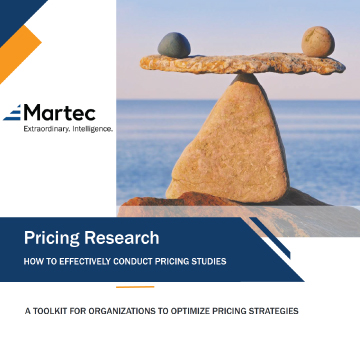This is Part Two of a three-part series on pricing strategies to help companies navigate the uncertain future that inflation and ongoing supply chain issues are creating. For Part One on Price-Value Mapping, click here. To read all three installments in full detail, complete with graphics, illustrations, and applicable case studies, download the full eBook here.
Companies must continuously find ways to take cost out of their value chain and win the competition for market share, whether in uncertain times or relatively more predictable and consistent market conditions. Previously, a strategy of high volume and scale based on low-cost labor and transportation has worked, but recent Covid-era issues signal that this is no longer a reliable strategy, at least in the short-term (and for who knows how long). Persistent inflation and ongoing supply chain disruptions, combined with rising production costs, is creating an imperfect storm of pricing pressures for companies.
Now is an optimal time to assess and refresh your pricing strategy—to better position yourself for what the short-term future holds, as well as to set up your company, brand, and products for growth well into the future. One such methodology is a research study developed exclusively by The Martec Group, and one that is already paying dividends for companies who pursue it.
What Is Benefit-Value Analysis?
Benefit-Value Analysis (BVA) is a proprietary methodology developed by Martec to gain insights from an intended market to determine appropriate and acceptable pricing strategies on products before they are introduced and released into the marketplace.
The goal of BVA studies is to understand what features and benefits customers are willing to pay for and to quantify that willingness into a recommended pricing strategy. This type of study includes assessing questions like:
- Is the customer willing to pay more for a given feature based on the value they perceive the product or feature enhancement provides?
- If the customer is willing to pay more, how much more will they pay?
- Can we quantify how much more the customer is willing to pay, at various proposed price points?
One of the many benefits of BVA is that it allows manufacturers to understand market willingness to pay value premiums on new features…often even before product enhancements are commercialized. In some cases, this methodology can be applied prior to the development phase, enabling manufacturers to quantify and qualify pricing strategies before product development investments are made.
Going further, in one application of Martec’s Benefit-Value Analysis methodology, a product manufacturer was able to perform a BVA study without revealing the actual product. This was critically important to the client and provided pricing insights without alerting the market to a potentially game-changing product enhancement. It is important to note (as was explained to the client), that employing the BVA pricing methodology while revealing the actual product, rather than on the proposed benefits, may return a different premium calculation.
The reasons manufacturers find this process innovation valuable are manifold:
- Benefit-Value Analysis allows manufacturers to establish market-tested pricing for new-to-the-world products, even if they don’t technically exist yet.
- The methodology can provide theoretical pricing for an undefined product, based on benefits alone.
- Since BVA combines both qualitative and quantitative approaches and integrates feedback on specific benefits/value statements, this process provides valuable, real-world, customer insights that help to define the value proposition and future marketing strategies.
- BVA can provide product developers the opportunity to iterate new products conceptually, saving money on research, development, and prototyping costs.
How Benefit-Value Analysis Helps
It’s important to apply some number-crunching and analysis techniques to truly mine the data for business intelligence. There is a nuance to calculating the ultimate pricing premium a market will bear for product enhancements and additional features that isn’t merely additive to the baseline product price (which can potentially return errant results).
Our methodology for calculating premium pricing thresholds has proven exceptionally accurate and reliable when rolling out new features and products. Typically, it goes like this:
- Prioritizing benefits:
– Which proposed benefits are deemed most important by the customer? - Quantifying perceived benefits:
– What percentage of respondents are willing to pay more?
– How much more are they willing to pay?
– How many of the proposed benefits are customers willing to pay for? - Martec calculus of Benefit-Value Analysis:
– Start with the baseline product cost of X.
– Weight each benefit by prioritization rank (from the MaxDiff analysis).
– Multiply the most preferred benefits by the percentage of people willing to pay for them.
– Then, multiply that by the percentage increase customers are willing to pay over the baseline product cost of X.
– Finally, multiply the calculated premium by the percent of benefits customers are willing to pay for (i.e., if customers are willing to pay for 33% of the proposed benefits, a potential $1,500 premium may be only $500).
Once the study is complete, the data analyzed, and the formulas applied, the manufacturer gets a clear, data-backed picture as to which specific benefits customers are looking for. More importantly, they now understand what benefits customers are willing to pay more for over others…how much more…and to what specific extent (or upper pricing threshold).
To get these answers, while maintaining the ability to withhold potentially sensitive product concept information, Benefit-Value Analysis provides a cost-effective solution to deliver enhanced value to your customers and brand.
See Benefit-Value Analysis in Action
A comprehensive Benefit-Value Analysis study almost always begins with a MaxDiff exercise. Such a study would ask respondents to prioritize the importance they place on various proposed benefits. This can help determine which benefits will have the greatest impact on adoption, willingness to purchase, etc. and provides key input for the final pricing model.
Download the eBook, “Pricing Research: How to Effectively Conduct Pricing Studies,” now to see an in-depth explanation of the methodologies applied during Benefits-Value Analysis, many of which are proprietary and unique to Martec.
The combination of both quantitative and qualitative feedback in BVA research studies provides product development teams and manufacturers with market-based data and insights on pricing and customer appetite for premium features and benefits. It also highlights customer motivators and de-motivators that can later be applied to marketing strategies, advertising messaging, and product roll-out planning.
In times of volatility and uncertainty, Benefit-Value Analysis represents a valuable tool in the toolbox. BVA can help companies achieve greater confidence in their pricing strategies, especially when entering new, unfamiliar, and adjacent markets.
This is Part Two of a three-part series on pricing strategies to help companies navigate the future. Other chapters in the eBook cover the concepts of Price-Value Mapping and Competitive Price Benchmarking.
To read all three installments in full detail, complete with graphics, illustrations, and applicable case studies, download the full report today.





